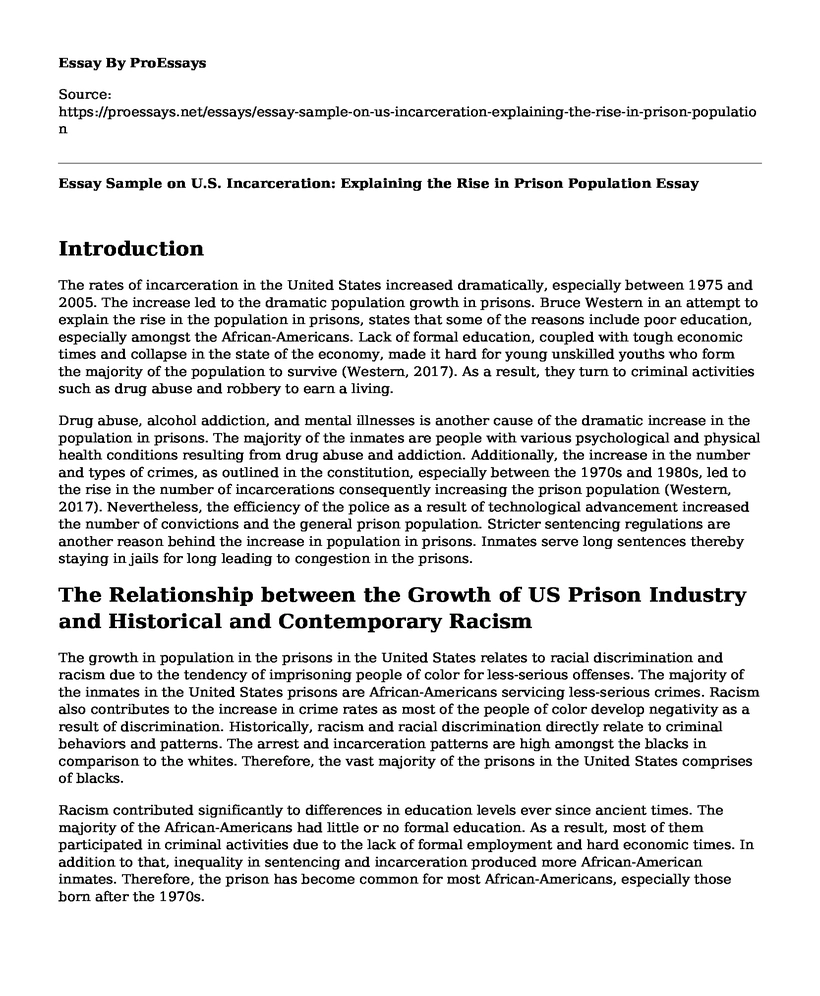Introduction
The rates of incarceration in the United States increased dramatically, especially between 1975 and 2005. The increase led to the dramatic population growth in prisons. Bruce Western in an attempt to explain the rise in the population in prisons, states that some of the reasons include poor education, especially amongst the African-Americans. Lack of formal education, coupled with tough economic times and collapse in the state of the economy, made it hard for young unskilled youths who form the majority of the population to survive (Western, 2017). As a result, they turn to criminal activities such as drug abuse and robbery to earn a living.
Drug abuse, alcohol addiction, and mental illnesses is another cause of the dramatic increase in the population in prisons. The majority of the inmates are people with various psychological and physical health conditions resulting from drug abuse and addiction. Additionally, the increase in the number and types of crimes, as outlined in the constitution, especially between the 1970s and 1980s, led to the rise in the number of incarcerations consequently increasing the prison population (Western, 2017). Nevertheless, the efficiency of the police as a result of technological advancement increased the number of convictions and the general prison population. Stricter sentencing regulations are another reason behind the increase in population in prisons. Inmates serve long sentences thereby staying in jails for long leading to congestion in the prisons.
The Relationship between the Growth of US Prison Industry and Historical and Contemporary Racism
The growth in population in the prisons in the United States relates to racial discrimination and racism due to the tendency of imprisoning people of color for less-serious offenses. The majority of the inmates in the United States prisons are African-Americans servicing less-serious crimes. Racism also contributes to the increase in crime rates as most of the people of color develop negativity as a result of discrimination. Historically, racism and racial discrimination directly relate to criminal behaviors and patterns. The arrest and incarceration patterns are high amongst the blacks in comparison to the whites. Therefore, the vast majority of the prisons in the United States comprises of blacks.
Racism contributed significantly to differences in education levels ever since ancient times. The majority of the African-Americans had little or no formal education. As a result, most of them participated in criminal activities due to the lack of formal employment and hard economic times. In addition to that, inequality in sentencing and incarceration produced more African-American inmates. Therefore, the prison has become common for most African-Americans, especially those born after the 1970s.
Western's Most Important Conclusions
Western believes that the rapidly growing population in prisons in the United States is due to factors such as social inequality, inadequate education systems, lack of formal employment, racism, and tough economic times. Poor education and lack of employment opportunities are the foundation of social problems such as drug abuse, sexual crimes, and robbery as well as contributing to mental and physical health issues. A proportionate number of inmates in the prisons in the United States are in jail as a result of any of these factors. Nevertheless, racism contributes to the rapidly growing prison population as the sentencing and judgment predominantly rely on racial considerations.
References
Western, B. (2017). The prison boom and the decline of American citizenship. In What Do We Owe Each Other? (pp. 101-116). Routledge.
Cite this page
Essay Sample on U.S. Incarceration: Explaining the Rise in Prison Population. (2023, Apr 10). Retrieved from https://proessays.net/essays/essay-sample-on-us-incarceration-explaining-the-rise-in-prison-population
If you are the original author of this essay and no longer wish to have it published on the ProEssays website, please click below to request its removal:
- Crime Prevention Through Environmental Design Essay
- Articles Analysis Essay on Child Abuse and Juvenile Delinquency
- False Confession by an Innocent Victim Essay Example
- Miranda Case Study
- Property Crime and Crimes Against People: What Do They Have in Common?
- Hong Kong: Safest City in the Industrialized World - Research Paper
- US Homeland Security: Established in Response to 9/11 Attacks - Research Paper







